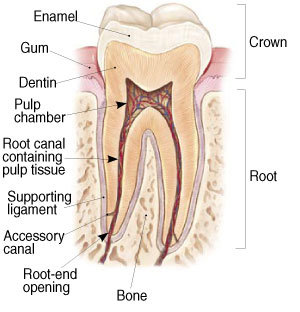
There are many options available to replace teeth. When a front tooth is lost in an accident, such as when playing a sport or in a car, time can be a major concern. Dentists can replace a tooth very quickly by fabricating a single tooth denture . Most people are not happy with their ability to chew with the denture in place, so they remove it when eating. Some have trouble talking with the denture at first, but speech improves with practice. This is the least expensive way to replace a tooth. Some patients will live with a denture for years before replacing it with a more permanent false tooth or another denture.
There are three basic ways to fix a missing tooth or teeth.
* A fixed bridge
* A removable appliance
* A dental implant
A fixed bridge
Having a bridge is like having three crowns. The teeth on either side of the missing tooth are prepared for crowns, an impression is made, and the case is sent to a dental laboratory. The laboratory then makes the crowns and fastens a false tooth between the two crowns – this is a bridge.The advantages of a bridge are that it is fixed, stable, and feels like your own teeth. In most cases it can be made to look just like you never had a tooth missing. The disadvantage is that you have to treat two teeth besides the one that was extracted – these teeth may otherwise be perfectly sound with nothing wrong.
A Removable Appliance.
Something removable can be used to replace a missing tooth. This can be anything from a budget “denture” (a piece of plastic with a false tooth attached) or a Cobalt Chromium, to a more sturdy metal and acrylic removable partial denture.The advantages of the removable partial denture appliance are that it is a more economical way to replace missing teeth than a fixed bridge. Also, you can replace multiple teeth with one appliance. If the span of missing teeth is three or more, or if there are not solid teeth on both sides of the missing teeth, a fixed bridge may not work.
The disadvantages are that it may not be as esthetic as a bridge. Clasps will be required to retain the removable partial, and it may not be possible or practical to entirely conceal those . Also, there may be some discomfort with wearing removable hardware in your mouth, and it is not as stable as a bridge.
A dental implant
A dental implant is an artificial “root” that is implanted in your jaw after a tooth extraction, and then a tooth is placed on it. Biologically, it is like placing an entirely new artificial tooth in your mouth.The advantages of an implant are: No teeth on either side have to be prepared for crowns, so there is no grinding on “good teeth” – you just fix the missing tooth. Implants can also span the space of multiple missing teeth. There is no limit to the span they can cover, as long as the patient’s health is good and there is healthy and adequate bone to support the implant. An implant also is fixed and feels just like your own teeth.
The disadvantages of implants are that they can cost more and be more and time-consuming, and the cost may not be covered by dental insurance. You will likely have to deal with two dentists – the dentist who does the surgery to place the implant, and the dentist who puts the false tooth on top of the implant. There is also a delay in getting the false tooth or teeth – a healing interval of several months may be required before the artificial root can have a tooth placed on it. There is also surgery involved with its attendant discomfort and healing period.
However, if you are missing multiple teeth or all your teeth, there is a strong advantage to dental implants in that they will preserve the jawbone. Sometimes dentists don’t explain the negative long-term consequences of missing teeth, which are that your jaw gradually shrinks until you can’t wear any removable appliance. So if you want to still be able to eat when you’re 80, you may want to consider investing in dental implants to replace those missing teeth.
Conclusion
Patients who do not replace missing teeth may experience shifting of teeth, spaces opening between teeth (resulting in food impaction), collapse of the bite, alterations in their chewing ability, TMJ pain, and trauma to the remaining teeth. People sometimes don’t replace teeth that are “in the back” of the mouth because no one sees them. The back teeth are needed to support the bite and grind up food. We can all swallow food that is not chewed thoroughly, but this compromises the nutrition we extract from our diet.
 Are you one of the millions of people that stifle laughs or are constantly trying to cover your mouth when you smile because you are embarrassed of your teeth? Many adults are unhappy with the appearance of their teeth but can’t face the prospect of wearing ugly fixed-metal braces for months or years on end. Now, a revolutionary new treatment is available called Six Month Smile which promises straighter teeth in, that’s right, just six months.
Are you one of the millions of people that stifle laughs or are constantly trying to cover your mouth when you smile because you are embarrassed of your teeth? Many adults are unhappy with the appearance of their teeth but can’t face the prospect of wearing ugly fixed-metal braces for months or years on end. Now, a revolutionary new treatment is available called Six Month Smile which promises straighter teeth in, that’s right, just six months.









